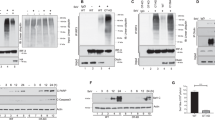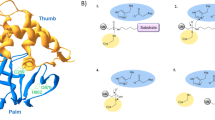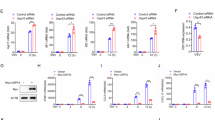Abstract
Lysine 63 (K63)-linked ubiquitination of RIG-I plays a critical role in the activation of type I interferon pathway, yet the molecular mechanism responsible for its deubiquitination is still poorly understood. Here we report that the deubiquitination enzyme ubiquitin-specific protease 3 (USP3) negatively regulates the activation of type I interferon signaling by targeting RIG-I. Knockdown of USP3 specifically enhanced K63-linked ubiquitination of RIG-I, upregulated the phosphorylation of IRF3 and augmented the production of type I interferon cytokines and antiviral immunity. We further show that there is no interaction between USP3 and RIG-I-like receptors (RLRs) in unstimulated or uninfected cells, but upon viral infection or ligand stimulation, USP3 binds to the caspase activation recruitment domain of RLRs and then cleaves polyubiquitin chains through cooperation of its zinc-finger Ub-binding domain and USP catalytic domains. Mutation analysis reveals that binding of USP3 to polyubiquitin chains on RIG-I is a prerequisite step for its cleavage of polyubiquitin chains. Our findings identify a previously unrecognized role of USP3 in RIG-I activation and provide insights into the mechanisms by which USP3 inhibits RIG-I signaling and antiviral immunity.
Similar content being viewed by others
Log in or create a free account to read this content
Gain free access to this article, as well as selected content from this journal and more on nature.com
or
References
Takeuchi O, Akira S . Pattern recognition receptors and inflammation. Cell 2010; 140:805–820.
Loo YM, Gale M Jr . Immune signaling by RIG-I-like receptors. Immunity 2011; 34:680–692.
Barbalat R, Ewald SE, Mouchess ML, Barton GM . Nucleic acid recognition by the innate immune system. Annu Rev Immunol 2011; 29:185–214.
Chiu YH, Macmillan JB, Chen ZJ . RNA polymerase III detects cytosolic DNA and induces type I interferons through the RIG-I pathway. Cell 2009; 138:576–591.
Ablasser A, Bauernfeind F, Hartmann G, Latz E, Fitzgerald KA, Hornung V . RIG-I-dependent sensing of poly(dA:dT) through the induction of an RNA polymerase III-transcribed RNA intermediate. Nat Immunol 2009; 10:1065–1072.
Takaoka A, Wang Z, Choi MK, et al. DAI (DLM-1/ZBP1) is a cytosolic DNA sensor and an activator of innate immune response. Nature 2007; 448:501–505.
Fernandes-Alnemri T, Yu JW, Datta P, Wu J, Alnemri ES . AIM2 activates the inflammasome and cell death in response to cytoplasmic DNA. Nature 2009; 458:509–513.
Hornung V, Ablasser A, Charrel-Dennis M, et al. AIM2 recognizes cytosolic dsDNA and forms a caspase-1-activating inflammasome with ASC. Nature 2009; 458:514–518.
Unterholzner L, Keating SE, Baran M, et al. IFI16 is an innate immune sensor for intracellular DNA. Nat Immunol 2010; 11:997–1004.
Zhang Z, Yuan B, Bao M, Lu N, Kim T, Liu YJ . The helicase DDX41 senses intracellular DNA mediated by the adaptor STING in dendritic cells. Nat Immunol 2011; 12:959–965.
Theofilopoulos AN, Baccala R, Beutler B, Kono DH . Type I interferons (alpha/beta) in immunity and autoimmunity. Annu Rev Immunol 2005; 23:307–336.
Eisenacher K, Krug A . Regulation of RLR-mediated innate immune signaling -- it is all about keeping the balance. Eur J Cell Biol 2012; 91:36–47.
Liew FY, Xu D, Brint EK, O'Neill LA . Negative regulation of toll-like receptor-mediated immune responses. Nat Rev Immunol 2005; 5:446–458.
Bhoj VG, Chen ZJ . Ubiquitylation in innate and adaptive immunity. Nature 2009; 458:430–437.
Peisley A, Lin C, Wu B, et al. Cooperative assembly and dynamic disassembly of MDA5 filaments for viral dsRNA recognition. Proc Natl Acad Sci USA 2011; 108:21010–21015.
Peisley A, Jo MH, Lin C, et al. Kinetic mechanism for viral dsRNA length discrimination by MDA5 filaments. Proc Natl Acad Sci USA 2012; 109:E3340–E3349.
Hou F, Sun L, Zheng H, Skaug B, Jiang QX, Chen ZJ . MAVS forms functional prion-like aggregates to activate and propagate antiviral innate immune response. Cell 2011; 146:448–461.
Jiang F, Ramanathan A, Miller MT, et al. Structural basis of RNA recognition and activation by innate immune receptor RIG-I. Nature 2011; 479:423–427.
Kowalinski E, Lunardi T, McCarthy AA, et al. Structural basis for the activation of innate immune pattern-recognition receptor RIG-I by viral RNA. Cell 2011; 147:423–435.
Zeng W, Sun L, Jiang X, et al. Reconstitution of the RIG-I pathway reveals a signaling role of unanchored polyubiquitin chains in innate immunity. Cell 2010; 141:315–330.
Gack MU, Shin YC, Joo CH, et al. TRIM25 RING-finger E3 ubiquitin ligase is essential for RIG-I-mediated antiviral activity. Nature 2007; 446:916–920.
Oshiumi H, Miyashita M, Inoue N, Okabe M, Matsumoto M, Seya T . The ubiquitin ligase riplet is essential for RIG-I-dependent innate immune responses to RNA virus infection. Cell Host Microbe 2010; 8:496–509.
Nicassio F, Corrado N, Vissers JH, et al. Human USP3 is a chromatin modifier required for S phase progression and genome stability. Curr Biol 2007; 17:1972–1977.
Karin M, Lawrence T, Nizet V . Innate immunity gone awry: linking microbial infections to chronic inflammation and cancer. Cell 2006; 124:823–835.
Cui J, Zhu L, Xia X, et al. NLRC5 negatively regulates the NF-kappaB and type I interferon signaling pathways. Cell 2010; 141:483–496.
Xia X, Cui J, Wang HY, et al. NLRX1 negatively regulates TLR-induced NF-κB signaling by targeting TRAF6 and IKK. Immunity 2011; 34:843–853.
Moore CB, Bergstralh DT, Duncan JA, et al. NLRX1 is a regulator of mitochondrial antiviral immunity. Nature 2008; 451:573–577.
Allen IC, Moore CB, Schneider M, et al. NLRX1 protein attenuates inflammatory responses to infection by interfering with the RIG-I-MAVS and TRAF6-NF-kappaB signaling pathways. Immunity 2011; 34:854–865.
Jia Y, Song T, Wei C, et al. Negative regulation of MAVS-mediated innate immune response by PSMA7. J Immunol 2009; 183:4241–4248.
You F, Sun H, Zhou X, et al. PCBP2 mediates degradation of the adaptor MAVS via the HECT ubiquitin ligase AIP4. Nat Immunol 2009; 10:1300–1308.
Cui J, Li Y, Zhu L, et al. NLRP4 negatively regulates type I interferon signaling by targeting the kinase TBK1 for degradation via the ubiquitin ligase DTX4. Nat Immunol 2012; 13:387–395.
Luo D, Ding SC, Vela A, Kohlway A, Lindenbach BD, Pyle AM . Structural insights into RNA recognition by RIG-I. Cell 2011; 147:409–422.
Oshiumi H, Matsumoto M, Hatakeyama S, Seya T . Riplet/RNF135, a RING finger protein, ubiquitinates RIG-I to promote interferon-beta induction during the early phase of viral infection. J Biol Chem 2009; 284:807–817.
Jiang X, Kinch LN, Brautigam CA, et al. Ubiquitin-induced oligomerization of the RNA sensors RIG-I and MDA5 activates antiviral innate immune response. Immunity 2012; 36:959–973.
Lin R, Yang L, Nakhaei P, et al. Negative regulation of the retinoic acid-inducible gene I-induced antiviral state by the ubiquitin-editing protein A20. J Biol Chem 2006; 281:2095–2103.
Zhang M, Wu X, Lee AJ, et al. Regulation of IkappaB kinase-related kinases and antiviral responses by tumor suppressor CYLD. J Biol Chem 2008; 283:18621–18626.
Arimoto K, Takahashi H, Hishiki T, Konishi H, Fujita T, Shimotohno K . Negative regulation of the RIG-I signaling by the ubiquitin ligase RNF125. Proc Natl Acad Sci USA 2007; 104:7500–7505.
Chen W, Han C, Xie B, et al. Induction of Siglec-G by RNA viruses inhibits the innate immune response by promoting RIG-I degradation. Cell 2013; 152:467–478.
Chen R, Zhang L, Zhong B, Tan B, Liu Y, Shu HB . The ubiquitin-specific protease 17 is involved in virus-triggered type I IFN signaling. Cell Res 2010; 20:802–811.
Acknowledgements
We would like to thank Dr Jianhua Yang (Baylor College of Medicine) for USP3 and other USP (without tag) plasmids. This work was in part supported by grants (CA090327, CA101795, CA121191, CA116408, CA094327 and DA030338) from NCI, NIH and Cancer Prevention and Research Institute of Texas (CPRIT RP121048) (to RFW), and the National Natural Science Foundation of China (31000394 and 31370869), the National Key Basic Research Program of China (2014CB910800), Guangdong Innovative Research Team Program (2011Y035 and 201001Y0104687244) and Guangdong Natural Science Funds for Distinguished Young Scholar (S2013050014772).
Author information
Authors and Affiliations
Corresponding authors
Additional information
( Supplementary information is linked to the online version of the paper on the Cell Research website.)
Supplementary information
Supplementary information, Figure S1
USP3 negatively regulates dsRNA and dsDNA induced type I IFN signaling. (PDF 198 kb)
Supplementary information, Figure S2
Knockdown of Usp3 enhances type I IFN signaling and IFN-β production. (PDF 328 kb)
Supplementary information, Figure S3
USP3 inhibits type I IFN signaling through RIG-I or MDA5. (PDF 340 kb)
Supplementary information, Figure S4
USP3 specifically interacts with RIG-I and MDA5 in a ligand-dependent manner. (PDF 113 kb)
Supplementary information, Figure S5
USP3 inhibits IRF3 activation by deubiquitinating K63-linked polyubiquitin chains. (PDF 274 kb)
Supplementary information, Figure S6
Effects of USP3 deletions and mutations on RIG-I ubiquitination and RIG-I (N)-induced ISRE-luc activity. (PDF 169 kb)
Supplementary information, Figure S7
USP3 specifically binds to the ubiquitinated RIG-I and MDA5 with a K63 linage. (PDF 153 kb)
Rights and permissions
About this article
Cite this article
Cui, J., Song, Y., Li, Y. et al. USP3 inhibits type I interferon signaling by deubiquitinating RIG-I-like receptors. Cell Res 24, 400–416 (2014). https://doi.org/10.1038/cr.2013.170
Received:
Revised:
Accepted:
Published:
Issue date:
DOI: https://doi.org/10.1038/cr.2013.170
Keywords
This article is cited by
-
Ubiquitin ligase enzymes and de-ubiquitinating enzymes regulate innate immunity in the TLR, NLR, RLR, and cGAS-STING pathways
Immunologic Research (2023)
-
Application and prospect of targeting innate immune sensors in the treatment of autoimmune diseases
Cell & Bioscience (2022)
-
Ubiquitin-specific protease 3 facilitates cell proliferation by deubiquitinating pyruvate kinase L/R in gallbladder cancer
Laboratory Investigation (2022)
-
USP3 deubiquitinates and stabilizes the adapter protein ASC to regulate inflammasome activation
Cellular & Molecular Immunology (2022)
-
Protein deubiquitylase USP3 stabilizes Aurora A to promote proliferation and metastasis of esophageal squamous cell carcinoma
BMC Cancer (2021)



